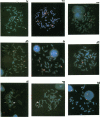Abstract
We have characterized 17 rob(13q14q) Robertsonian translocations, using six molecular probes that hybridize to the repetitive sequences of the centromeric and shortarm regions of the five acrocentric chromosomes by FISH. The rearrangements include six de novo rearrangements and the chromosomally normal parents, five maternally and three paternally inherited translocations, and three translocations of unknown origin. The D21Z1/D13Z1 and D14Z1/D22Z1 centromeric alpha-satellite DNA probes showed all rob(13q14q) chromosomes to be dicentric. The rDNA probes did not show hybridization on any of the 17 cases studied. The pTRS-47 satellite III DNA probe specific for chromosomes 14 and 22 was retained around the breakpoints in all cases. However, the pTRS-63 satellite III DNA probe specific for chromosome 14 did not show any signals on the translocation chromosomes examined. In 16 of 17 translocations studied, strong hybridization signals on the translocations were detected with the pTRI-6 satellite I DNA probe specific for chromosome 13. All parents of the six de novo rob(13q14q), including one whose pTRI-6 sequence was lost, showed strong positive hybridization signals on each pair of chromosomes 14 and 13, with pTRS-47, pTRS-63, and pTRI-6. Therefore, the translocation breakpoints in the majority of rob(13q14q) are between the pTRS-47 and pTRS-63 sequences in the p11 region of chromosome 14 and between the pTRI-6 and rDNA sequences within the p11 region of chromosome 13.
Full text
PDF

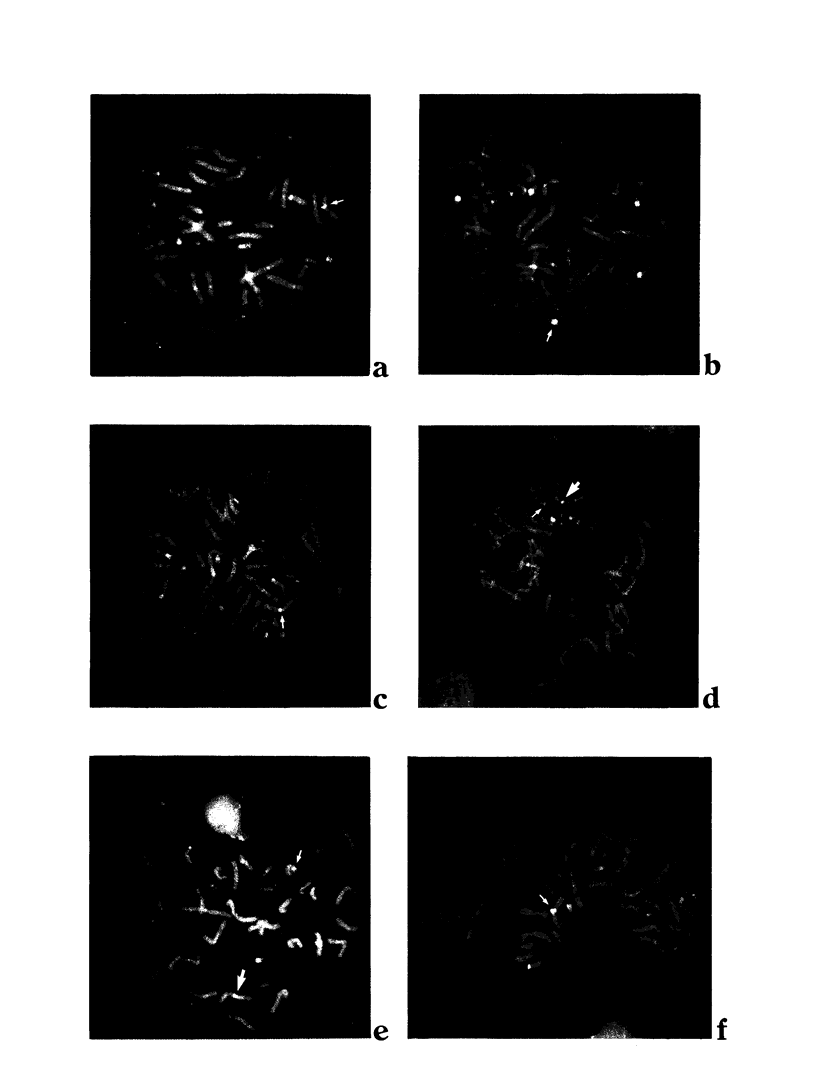
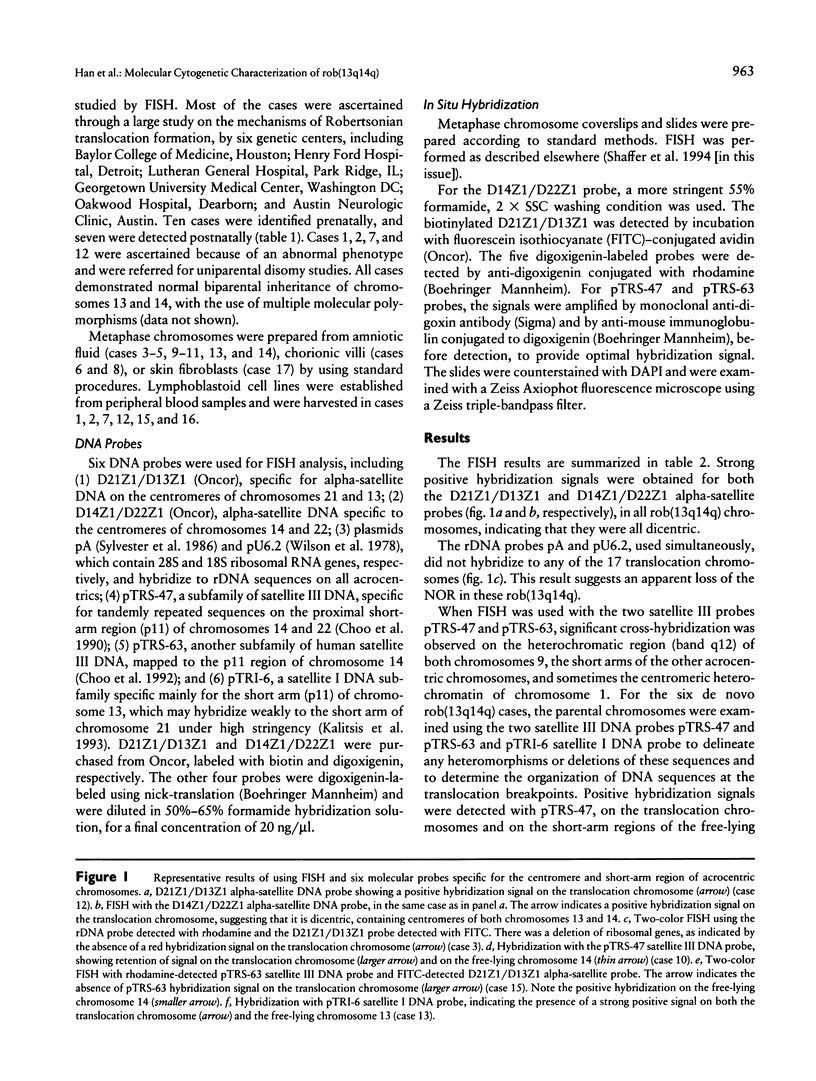
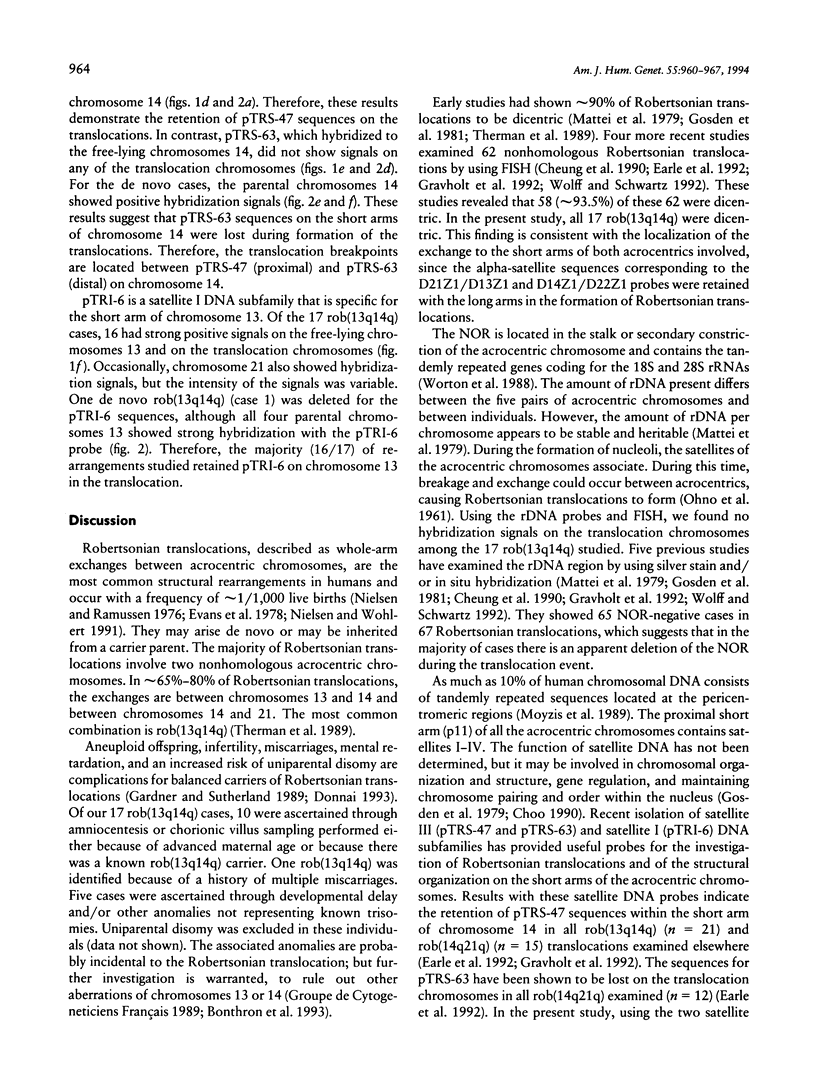

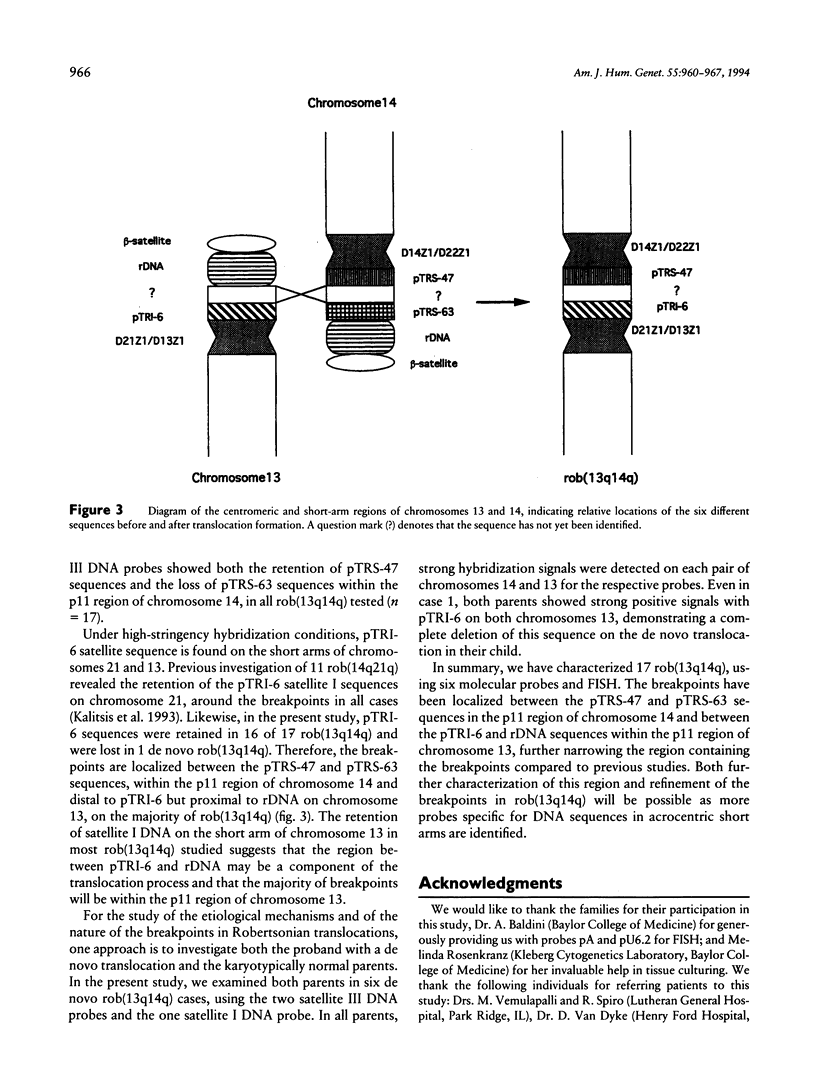
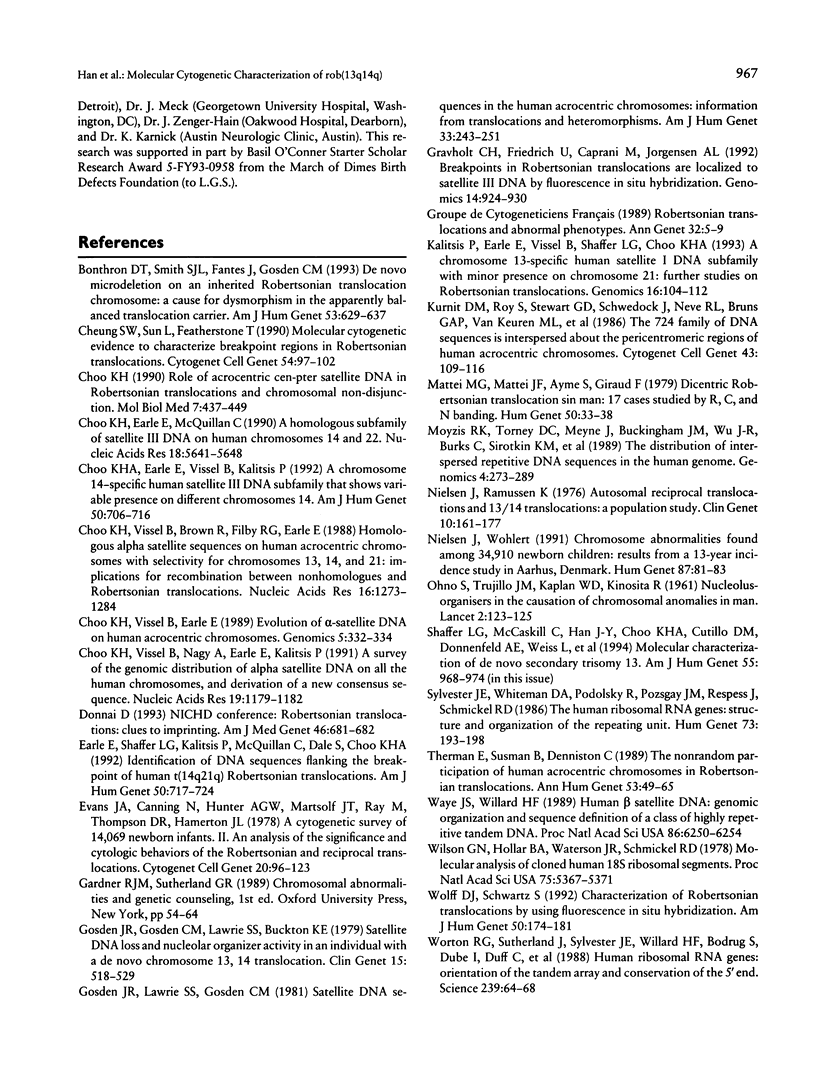
Images in this article
Selected References
These references are in PubMed. This may not be the complete list of references from this article.
- Bonthron D. T., Smith S. J., Fantes J., Gosden C. M. De novo microdeletion on an inherited Robertsonian translocation chromosome: a cause for dysmorphism in the apparently balanced translocation carrier. Am J Hum Genet. 1993 Sep;53(3):629–637. [PMC free article] [PubMed] [Google Scholar]
- Cheung S. W., Sun L., Featherstone T. Molecular cytogenetic evidence to characterize breakpoint regions in Robertsonian translocations. Cytogenet Cell Genet. 1990;54(3-4):97–102. doi: 10.1159/000132970. [DOI] [PubMed] [Google Scholar]
- Choo K. H., Earle E., McQuillan C. A homologous subfamily of satellite III DNA on human chromosomes 14 and 22. Nucleic Acids Res. 1990 Oct 11;18(19):5641–5648. doi: 10.1093/nar/18.19.5641. [DOI] [PMC free article] [PubMed] [Google Scholar]
- Choo K. H., Earle E., Vissel B., Kalitsis P. A chromosome 14-specific human satellite III DNA subfamily that shows variable presence on different chromosomes 14. Am J Hum Genet. 1992 Apr;50(4):706–716. [PMC free article] [PubMed] [Google Scholar]
- Choo K. H. Role of acrocentric cen-pter satellite DNA in Robertsonian translocation and chromosomal non-disjunction. Mol Biol Med. 1990 Oct;7(5):437–449. [PubMed] [Google Scholar]
- Choo K. H., Vissel B., Brown R., Filby R. G., Earle E. Homologous alpha satellite sequences on human acrocentric chromosomes with selectivity for chromosomes 13, 14 and 21: implications for recombination between nonhomologues and Robertsonian translocations. Nucleic Acids Res. 1988 Feb 25;16(4):1273–1284. doi: 10.1093/nar/16.4.1273. [DOI] [PMC free article] [PubMed] [Google Scholar]
- Choo K. H., Vissel B., Earle E. Evolution of alpha-satellite DNA on human acrocentric chromosomes. Genomics. 1989 Aug;5(2):332–344. doi: 10.1016/0888-7543(89)90066-9. [DOI] [PubMed] [Google Scholar]
- Choo K. H., Vissel B., Nagy A., Earle E., Kalitsis P. A survey of the genomic distribution of alpha satellite DNA on all the human chromosomes, and derivation of a new consensus sequence. Nucleic Acids Res. 1991 Mar 25;19(6):1179–1182. doi: 10.1093/nar/19.6.1179. [DOI] [PMC free article] [PubMed] [Google Scholar]
- Donnai D. NICHD conference. Robertsonian translocations: clues to imprinting. Am J Med Genet. 1993 Jul 1;46(6):681–682. doi: 10.1002/ajmg.1320460615. [DOI] [PubMed] [Google Scholar]
- Earle E., Shaffer L. G., Kalitsis P., McQuillan C., Dale S., Choo K. H. Identification of DNA sequences flanking the breakpoint of human t(14q21q) Robertsonian translocations. Am J Hum Genet. 1992 Apr;50(4):717–724. [PMC free article] [PubMed] [Google Scholar]
- Evans J. A., Canning N., Hunter A. G., Martsolf J. T., Ray M., Thompson D. R., Hamerton J. L. A cytogenetic survey of 14,069 newborn infants. III. an analysis of the significance and cytologic behavior of the Robertsonian and reciprocal translocations. Cytogenet Cell Genet. 1978;20(1-6):96–123. doi: 10.1159/000130843. [DOI] [PubMed] [Google Scholar]
- Gosden J. R., Gosden C. M., Lawrie S. S., Buckton K. E. Satellite DNA loss and nucleolar organiser activity in an individual with a de novo chromosome 13,14 translocation. Clin Genet. 1979 Jun;15(6):518–529. doi: 10.1111/j.1399-0004.1979.tb00836.x. [DOI] [PubMed] [Google Scholar]
- Gosden J. R., Lawrie S. S., Gosden C. M. Satellite DNA sequences in the human acrocentric chromosomes: information from translocations and heteromorphisms. Am J Hum Genet. 1981 Mar;33(2):243–251. [PMC free article] [PubMed] [Google Scholar]
- Gravholt C. H., Friedrich U., Caprani M., Jørgensen A. L. Breakpoints in Robertsonian translocations are localized to satellite III DNA by fluorescence in situ hybridization. Genomics. 1992 Dec;14(4):924–930. doi: 10.1016/s0888-7543(05)80113-2. [DOI] [PubMed] [Google Scholar]
- Kalitsis P., Earle E., Vissel B., Shaffer L. G., Choo K. H. A chromosome 13-specific human satellite I DNA subfamily with minor presence on chromosome 21: further studies on Robertsonian translocations. Genomics. 1993 Apr;16(1):104–112. doi: 10.1006/geno.1993.1147. [DOI] [PubMed] [Google Scholar]
- Kurnit D. M., Roy S., Stewart G. D., Schwedock J., Neve R. L., Bruns G. A., Van Keuren M. L., Patterson D. The 724 family of DNA sequences is interspersed about the pericentromeric regions of human acrocentric chromosomes. Cytogenet Cell Genet. 1986;43(1-2):109–116. doi: 10.1159/000132305. [DOI] [PubMed] [Google Scholar]
- Mattei M. G., Mattei J. F., Ayme S., Giraud F. Dicentric Robertsonian translocation in man. 17 cases studied by R,C, and N banding. Hum Genet. 1979;50(1):33–38. doi: 10.1007/BF00295586. [DOI] [PubMed] [Google Scholar]
- Moyzis R. K., Torney D. C., Meyne J., Buckingham J. M., Wu J. R., Burks C., Sirotkin K. M., Goad W. B. The distribution of interspersed repetitive DNA sequences in the human genome. Genomics. 1989 Apr;4(3):273–289. doi: 10.1016/0888-7543(89)90331-5. [DOI] [PubMed] [Google Scholar]
- Nielsen J., Rasmussen K. Autosomal reciprocal translocations and 13/14 translocations: a population study. Clin Genet. 1976 Sep;10(3):161–177. doi: 10.1111/j.1399-0004.1976.tb00029.x. [DOI] [PubMed] [Google Scholar]
- Nielsen J., Wohlert M. Chromosome abnormalities found among 34,910 newborn children: results from a 13-year incidence study in Arhus, Denmark. Hum Genet. 1991 May;87(1):81–83. doi: 10.1007/BF01213097. [DOI] [PubMed] [Google Scholar]
- OHNO S., TRUJILLO J. M., KAPLAN W. D., KINOSITA R. Nucleolus-organisers in the causation of chromosomal anomalies in man. Lancet. 1961 Jul 15;2(7194):123–126. doi: 10.1016/s0140-6736(61)92647-2. [DOI] [PubMed] [Google Scholar]
- Shaffer L. G., McCaskill C., Han J. Y., Choo K. H., Cutillo D. M., Donnenfeld A. E., Weiss L., Van Dyke D. L. Molecular characterization of de novo secondary trisomy 13. Am J Hum Genet. 1994 Nov;55(5):968–974. [PMC free article] [PubMed] [Google Scholar]
- Sylvester J. E., Whiteman D. A., Podolsky R., Pozsgay J. M., Respess J., Schmickel R. D. The human ribosomal RNA genes: structure and organization of the complete repeating unit. Hum Genet. 1986 Jul;73(3):193–198. doi: 10.1007/BF00401226. [DOI] [PubMed] [Google Scholar]
- Therman E., Susman B., Denniston C. The nonrandom participation of human acrocentric chromosomes in Robertsonian translocations. Ann Hum Genet. 1989 Jan;53(Pt 1):49–65. doi: 10.1111/j.1469-1809.1989.tb01121.x. [DOI] [PubMed] [Google Scholar]
- Waye J. S., Willard H. F. Human beta satellite DNA: genomic organization and sequence definition of a class of highly repetitive tandem DNA. Proc Natl Acad Sci U S A. 1989 Aug;86(16):6250–6254. doi: 10.1073/pnas.86.16.6250. [DOI] [PMC free article] [PubMed] [Google Scholar]
- Wilson G. N., Hollar B. A., Waterson J. R., Schmickel R. D. Molecular analysis of cloned human 18S ribosomal DNA segments. Proc Natl Acad Sci U S A. 1978 Nov;75(11):5367–5371. doi: 10.1073/pnas.75.11.5367. [DOI] [PMC free article] [PubMed] [Google Scholar]
- Wolff D. J., Schwartz S. Characterization of Robertsonian translocations by using fluorescence in situ hybridization. Am J Hum Genet. 1992 Jan;50(1):174–181. [PMC free article] [PubMed] [Google Scholar]
- Worton R. G., Sutherland J., Sylvester J. E., Willard H. F., Bodrug S., Dubé I., Duff C., Kean V., Ray P. N., Schmickel R. D. Human ribosomal RNA genes: orientation of the tandem array and conservation of the 5' end. Science. 1988 Jan 1;239(4835):64–68. doi: 10.1126/science.3336775. [DOI] [PubMed] [Google Scholar]




